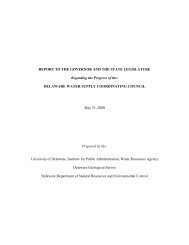Water Quality Trading in the Lower Delaware River Basin: A ...
Water Quality Trading in the Lower Delaware River Basin: A ...
Water Quality Trading in the Lower Delaware River Basin: A ...
Create successful ePaper yourself
Turn your PDF publications into a flip-book with our unique Google optimized e-Paper software.
The second issue of concern <strong>in</strong>volves multiple impairments. Consider a<br />
watershed with two impairments and two dischargers. The dischargers are not on <strong>the</strong><br />
same reach. One of <strong>the</strong> impairments is <strong>in</strong>fluenced by both discharges while <strong>the</strong> o<strong>the</strong>r<br />
impairment is <strong>in</strong>fluenced by only one discharger. Figure 2-4 shows this arrangement.<br />
Figure 2-4: Schematic of trad<strong>in</strong>g ratios <strong>in</strong> a system with multiple impairments<br />
Flow<br />
Flow<br />
Po<strong>in</strong>t Source A<br />
Po<strong>in</strong>t Source B<br />
Impairment A<br />
Impairment B<br />
PSA contributes to Impairment A and impairment B while PSB contributes only to<br />
impairment B. Trades between PSA and PSB are complex. If PSA buys a reduction<br />
from PSB, <strong>the</strong> reduction will benefit impairment B but not affect <strong>the</strong> impairment A. This<br />
trade is problematic because it over controls for impairment B and under controls for<br />
impairment A. Regulators <strong>in</strong>tended that some portion of <strong>the</strong> reduction that <strong>the</strong>y assigned<br />
to PSA would reduce <strong>the</strong> impairment <strong>in</strong> <strong>the</strong> vic<strong>in</strong>ity of PSA. But, this trade fails to<br />
consider <strong>the</strong> local impairment <strong>in</strong> <strong>the</strong> vic<strong>in</strong>ity of PSA. One potential solution to this<br />
problem is to divide <strong>the</strong> reduction requirement <strong>in</strong>to a component for <strong>the</strong> local impairment<br />
and <strong>the</strong> downstream impairment. The system could allow only trades that limit flow <strong>in</strong>to<br />
an impairment that is downstream of both dischargers. There are numerous permutations<br />
like this scenario. Each permutation is case specific and requires a unique solution and <strong>in</strong><br />
no case will trades be allow that will causes a local violation of water quality standards.<br />
The third issue <strong>in</strong>volves <strong>the</strong> uncerta<strong>in</strong>ty of <strong>the</strong> reductions of <strong>the</strong> vast array of<br />
mechanisms for NPS control. The determ<strong>in</strong>ation of a trad<strong>in</strong>g ratio for every possible<br />
mechanism of NPS reduction is not possible. The number of mechanisms and <strong>the</strong> unique<br />
effect that location has upon <strong>the</strong>se mechanisms makes this task cumbersome. One<br />
solution to <strong>the</strong> problem is to produce a list of preapproved mechanisms with predef<strong>in</strong>ed<br />
uncerta<strong>in</strong>ty. Dischargers who wish to purchase NPS reductions may choose from <strong>the</strong> list<br />
for which regulators have previously determ<strong>in</strong>ed <strong>the</strong> value of uncerta<strong>in</strong>ty for each<br />
30




